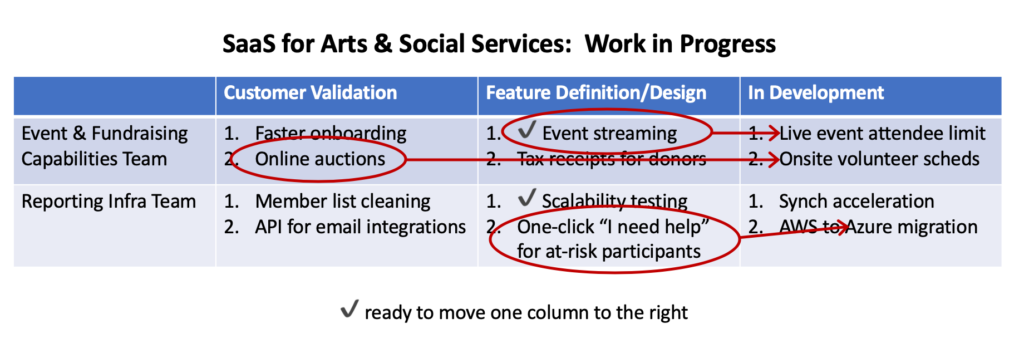I have about a dozen coaching/mentoring calls each week with product leaders, and the tone of those calls has just shifted. Through March and early April, most of the discussions were about making sure our workmates/family/friends were safe and able to connect virtually. This week, we’ve talked more about how COVID-19 and sheltering-in-place will shape near-term product decisions. Implications for customers, markets and company economics that may change what we build. Recapping both sets of conversations…
Safety, Emotional Status, Infrastructure First
Most product leaders — and thoughtful folks of all kinds/roles/locations — have been putting energy in basic health and safety issues. This is a time to demonstrate our humanity and empathy.
Alongside our families and neighbors, are our teams physically safe, heathy, fed? Checking in on people should be more important than checking up on deliverables. Listening and staying connected matter.
- If you’re able to reassure folks that their jobs are stable, you’ll address some of their biggest fears. Here in the US, people with chronic illnesses are terrified of losing their health insurance.
- Most contractors, independents and gig workers are seeing their incomes evaporate. If your company is able to keep funding outside projects, you’ll get their full attention and eternal loyalty.
Practicalities of working from home: folks on your extended team may not have laptops or broadband or headsets or a suitably quiet room for a temporary home office.
- Talk through synchronous vs. asynchronous vs. work assumptions. Some of us are putting in more hours (with not much else to do) while others are juggling complex home situations. You might decide that some meetings and group activity can be handled differently, such as commenting individually on docs instead of scheduling collective reviews. Or adjust assumptions about response times. Think about more inclusive meeting styles.
- Can your company drop-ship tech or supplies? Your team may need webcams, monitors, green screen drapes, low-end printer/scanners, or group subscriptions to Miro or Mural.
- We may pick up work-from-home tips from companies that intentionally built themselves as remote-only, such as Zapier and Doist.
Recognition that some of us face more complex challenges: parents with kids at home are doing triple duty as teachers and indoor athletic coaches; folks living alone may feel intensely lonely and isolated; people with at-risk relatives can be distracted/occupied elsewhere**.
- Consider some more personal kinds of support: meal delivery, sending toys or books or diapers or hand sanitizer, “bring your child or pet to the meeting” moments, virtual cocktails, departmental karaoke, mail-order chocolates for a team tasting.
- Assume that some of your team may need more (short-term) help around cross-functional strategies, complex planning or other “deep thinking” tasks during this very stressful period. If you can, make extra time to review their work and coach them through tough assignments.
Crisis Product Strategies
As product managers and leaders, though, we also have to think about how the crisis has changed the needs of our users/customers. Assumptions we made in January are probably shredded. How does COVID-19 shuffle our plans? What’s suddenly different about our customers’ economics or downstream markets or priorities? Anonymizing some examples from last week’s coaching calls:

You might have a SaaS product for arts and social service organizations. Plan-of-record is for features that manage on-premise volunteers and in-person fundraising events, but these suddenly look less urgent. Perhaps swap in group messaging or real-time event streaming or virtual auctions?
- Banking platforms may need emergency workflows to handle small business loans or temporary forgiveness of late payments. We might postpone improved account opening workflows.
- If your products enable remote work, this is a great time for free trial offers, how-to webinars and social media testimonials. Build your fan base now, since remote teams are replacing their old tools hour by hour. Long lead-time partnerships with huge corporations can probably wait.
- If your company primarily serves companies in transportation, travel, retail, restaurants or live events, you’re probably looking at dramatic downsizing and reducing cash burn. Can you afford to give good customers extended payment options while they fight to stay in business? Could better reporting/insights help them identify their best remaining customers and stay in business? How much DevOps is required to keep the lights on?
Inevitably, B2B companies will be pushed hard by their largest customers for one-offs or specials or custom work. We should be evaluating those against the needs of our overall customer base: will that new feature really add huge crisis value to large numbers of our users? If so, get something quick-and-dirty out next week. If not, push back aggressively so that you don’t give away your one crisis slot for something marginal.
Sound Byte
Making sure your team is safe (and still employed) is first priority. But our product management expertise is especially valuable in a crisis: let’s think clearly and strategically about shuffled priorities so that we support our customer base when it really matters.
*with apologies to the late Nobel novelist Gabriel García Márquez
** Karen Catlin’s Better Allies work helps me remember that not everyone has the same resources or situation

